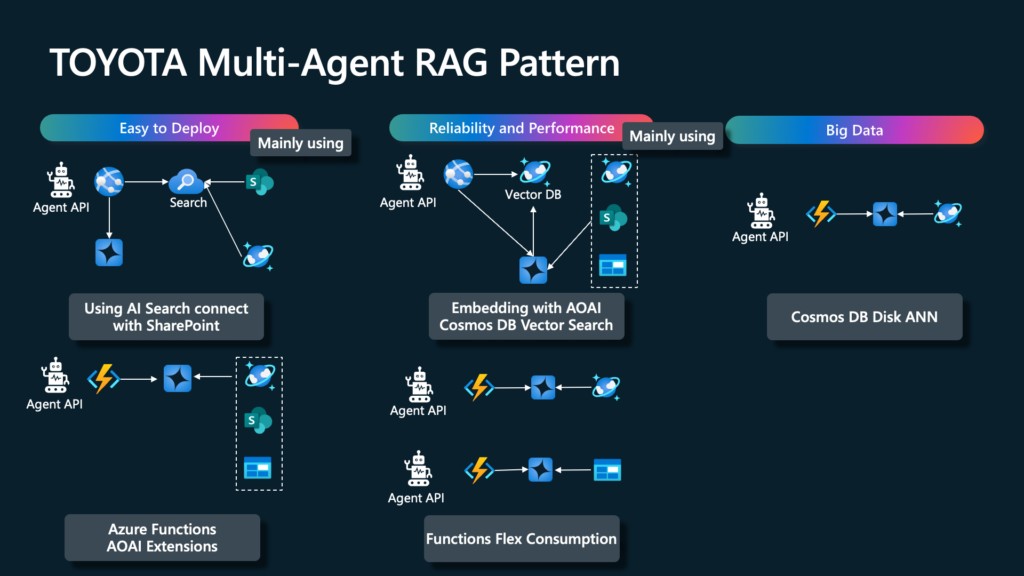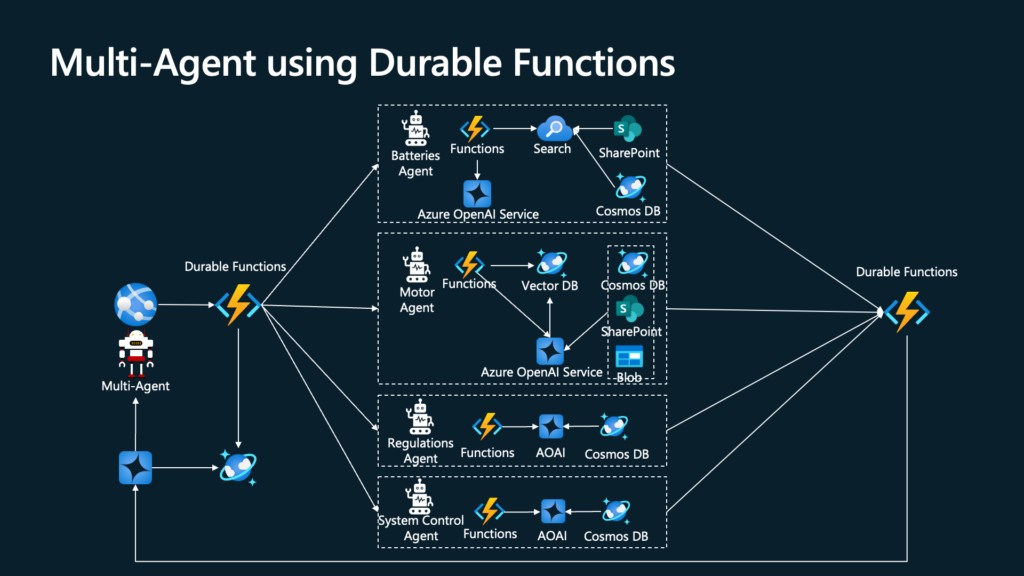Toyota, a global leader in automotive innovation, is constantly seeking ways to enhance its vehicle development processes. In a move to boost efficiency and accelerate the design of new car models, Toyota has integrated Azure Cosmos DB into its cutting-edge multi-agent AI system. This strategic adoption marks a significant step forward in leveraging advanced technology to meet the demands of the fiercely competitive automotive industry.
The Imperative for Innovation in Automotive Design
For a company like Toyota, synonymous with pioneering production methodologies and exceptional vehicle quality, the pressure to evolve is relentless. Boasting a workforce of approximately 380,793 employees and a staggering ¥45.095 trillion in sales as of March 2024, Toyota’s legacy is built on the renowned Toyota Production System (TPS). This system underpins their commitment to efficient manufacturing and superior quality control. Furthermore, Toyota has been at the forefront of developing hybrid and electric vehicle technologies, demonstrating a strong commitment to environmental sustainability.
However, the current automotive landscape is characterized by rapid technological advancements and intense market rivalry. This dynamic environment necessitates an agile and expedited approach to vehicle design and development. Toyota recognized that to maintain its leadership, it needed to optimize its design processes to be faster and more efficient than ever before.
Overcoming Design Development Bottlenecks
The traditional design development process at Toyota is inherently complex, drawing upon a vast repository of knowledge and specialized expertise. Designers must navigate a sea of information, including intricate component details, stringent specifications, a wealth of historical design documents, and ever-evolving regulatory standards. Historically, the sheer volume of data and the time required to access and synthesize relevant information posed a significant bottleneck. To foster innovation and accelerate development cycles, Toyota identified a critical need to streamline these information retrieval and processing workflows.
Generative AI emerged as a promising solution to empower Toyota’s designers. By harnessing the power of Azure OpenAI Service and implementing a sophisticated Retrieval-Augmented Generation (RAG) pattern, which intelligently utilizes Azure AI Search in conjunction with Toyota’s extensive internal design data, Toyota embarked on building an intelligent expert AI system. This system is specifically designed to act as a powerful assistant to design teams, providing rapid access to critical information and insights. A paramount concern in developing this AI assistant was ensuring accuracy and minimizing hallucinations, thereby providing reliable and precise responses to the diverse inquiries from designers.
Azure Cosmos DB: The Cornerstone of Toyota’s AI System
The selection of a robust and scalable database solution was pivotal for the success of Toyota’s AI initiative. The system needed to accommodate a large number of concurrent users seamlessly and offer the flexibility to manage dynamic conversational data. Crucially, it had to facilitate efficient vector searches across all interactions between designers and AI agents. After careful evaluation, Azure Cosmos DB was chosen as the foundational database for Toyota’s AI system.
Azure Cosmos DB’s architecture offered the unparalleled scalability required to support a growing user base. Its schema-less, document-based design provided the essential flexibility to effectively manage the fluid and evolving nature of conversational interactions between designers and AI agents. This architecture empowered Toyota to construct an expert AI system capable of delivering accurate and contextually relevant responses based on the complete history of interactions. Furthermore, Azure Cosmos DB enabled granular control over access to sensitive internal data, ensuring that designers only accessed information relevant to their permissions. This robust security framework not only enhanced data governance but also contributed to the system’s overall stability and operational security, facilitating continuous improvement in the system’s accuracy and reliability.
Recognizing the diverse specialized design areas within Toyota, the company expanded the expert AI system to encompass various domains. Each specialized AI agent is built with a distinct architecture and RAG pattern, independently optimized for accuracy and performance within its specific domain. For instance, when leveraging data from SharePoint, a RAG pattern incorporating Azure Cosmos DB and Azure AI Search was implemented. In architectures requiring operational data, vector data, and search functionalities, a RAG pattern utilizing Azure Cosmos DB and Azure OpenAI Service was adopted, showcasing the versatility of Azure Cosmos DB in diverse AI implementations within Toyota.
Alt text: Diagram illustrating Toyota’s expert AI system architecture, highlighting the integration of Azure Cosmos DB with Azure AI Search and Azure OpenAI Service for efficient data retrieval and processing in automotive design.
Embracing Multi-Agent AI Systems for Enhanced Collaboration
To propel innovation further, Toyota ventured into multi-agent AI systems, exploring the synergistic potential of collaborative AI agents. Through rigorous experimentation with agent frameworks like AutoGen from Microsoft Research and Azure OpenAI’s Function Calling, Toyota actively investigated the application of multi-agent systems in design development. The goal was to understand how these collaborative AI approaches could further amplify efficiency gains and foster deeper innovation.
This exploration culminated in the “O-Beya” system, a flagship multi-agent initiative born from Toyota’s AI experimentation in design development. “O-Beya,” meaning “big room” in Japanese, embodies the concept of collaborative engineering, bringing together designers from diverse specialized fields to work in close concert. The objective is to leverage their collective expertise and resources to design a vehicle model holistically, ensuring seamless integration of all components and systems. To empower this collaborative environment, Toyota aimed to create a multi-agent system that seamlessly integrates various specialized AI systems as expert agents. These agents would support a wide spectrum of use cases, including automated content generation, efficient document processing, intelligent summarization of complex data, and a sophisticated chat assistant to facilitate communication and knowledge sharing.
Alt text: Presentation slide depicting Toyota’s “O-Beya” multi-agent AI system, outlining the collaborative approach to vehicle design and the role of AI agents in enhancing efficiency and innovation.
The Architecture of “O-Beya”: Powered by Azure Durable Functions
Toyota explored various configurations for its multi-agent system, ultimately focusing on the robust capabilities of Azure Durable Functions. The “O-Beya” system is architected with four distinct agents, each specializing in a critical area of vehicle design: battery technology, motor engineering, regulatory compliance, and overall system control. Predefined prompts for each agent are meticulously crafted to guide their interactions and ensure cohesive responses from the multi-agent system. The decision to leverage Durable Functions was driven by three key advantages:
Firstly, Durable Functions enables parallel processing across agents, significantly boosting system performance and reducing response times. Secondly, it provides native support for complex workflows, including robust error handling and automated retry mechanisms, ensuring system resilience. Thirdly, Durable Functions facilitates effortless monitoring by externally storing system state, simplifying performance analysis and system review. In terms of implementation, Toyota utilized the fan-in/fan-out feature of Durable Functions. User requests trigger the main function, which initiates the four specialized agents, implemented as individual functions, in parallel using fan-out. Once all agents complete their parallel processes, fan-in aggregates the results, which are then synthesized by generative AI to formulate the final response, providing a comprehensive and integrated output to the user.
Each of the four specialized agents within the “O-Beya” system boasts its own unique architecture, finely tuned for optimal performance in its specific domain. To maximize response accuracy, Toyota continuously refines the RAG architecture and prompts for each agent, ensuring they are precisely tailored to their respective areas of expertise. Furthermore, by storing detailed conversation logs in Azure Cosmos DB, the system gains the ability to contextualize responses based on previous session data, enhancing the relevance and accuracy of subsequent interactions. A key architectural advantage of this design is the ease of adding new agents to the system. Since agents operate asynchronously and in parallel, incorporating additional agents does not negatively impact response times, allowing for seamless scalability. The primary challenge addressed during development was enhancing the precision of responses generated by each agent, which was effectively tackled through iterative refinement of each agent’s RAG implementation. The modular design, with individually implemented agents, also simplifies updates and maintenance, ensuring the long-term agility of the “O-Beya” system.
Alt text: Diagram illustrating the architecture of Toyota’s “O-Beya” system built on Azure Durable Functions, showcasing parallel processing of specialized AI agents and data aggregation with Azure Cosmos DB.
Early Success and Future Trajectory of “O-Beya”
The “O-Beya” system has marked a resounding success in Toyota’s journey of design development innovation. Currently deployed to 800 users across the company, the system handles over 100 requests per month, demonstrating its rapid adoption and increasing utility. While precise measurements of research time savings are still underway, user feedback overwhelmingly indicates a dramatic reduction in information search times. Looking ahead, Toyota plans to expand the number of specialized agents within the “O-Beya” system and continuously refine the accuracy of each agent, aiming for a transformative impact across the entire breadth of its business operations.
Charting Future Innovations with Azure Cosmos DB
Toyota’s commitment to pushing the boundaries of design development innovation remains unwavering. Ongoing trials are focused on further enhancing the multi-agent system, exploring the advanced vector search capabilities of Azure Cosmos DB to optimize RAG performance and investigating the implementation of GraphRAG over existing data using Azure Cosmos DB for NoSQL. These initiatives underscore Toyota’s dedication to leveraging Azure Cosmos DB’s evolving features to unlock even greater potential in its AI-driven design processes.
In conclusion, Toyota Motor Corporation’s strategic adoption of Azure Cosmos DB and the successful deployment of the “O-Beya” multi-agent AI system represents a pivotal advancement in automotive design development. By embracing cutting-edge technologies and fostering a culture of continuous innovation, Toyota is strategically positioned to maintain its competitive edge in the automotive industry, continuing its legacy of delivering high-quality, environmentally conscious vehicles to the global market.
About the Authors
| Kenji Onishi, Senior Manager, Powertrain Performance Development, Toyota Motor Corporation |
|---|
| Kosuke Miyasaka, Azure App Innovation Specialist |
| Keisuke Hatasaki, Azure Senior Specialist, GBB |



About Azure Cosmos DB
Azure Cosmos DB stands as a fully managed, serverless NoSQL and vector database, purpose-built for modern application development, including sophisticated AI applications. Renowned for its SLA-backed performance, high availability, and instant dynamic scalability, Azure Cosmos DB is the ideal database solution for real-time NoSQL and MongoDB applications demanding exceptional performance and distributed computing across massive datasets.
Try Azure Cosmos DB for free here.
Stay informed about the latest Azure Cosmos DB updates by following us on X, YouTube, and LinkedIn.
